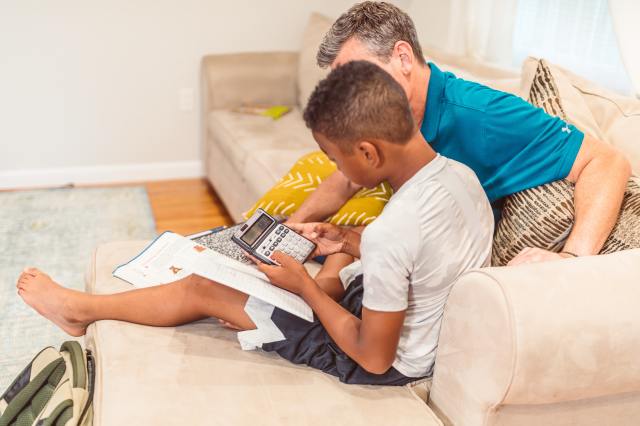Teaching young children how to handle their finances pays huge dividends (pun 100% intended) both now and in the future. Not sure how to craft age-appropriate lessons for your squad? We interviewed four financial professionals and came up with a list of 10 money skills that deliver the biggest bang for your buck. Read on for all the details.
1. Use Everyday Moments to Talk about Money

"It's important to have regular conversations about money management while your child is still young to push them towards positive financial outcomes in early adulthood," advises Jennifer Seitz, Educational Content Lead at Greenlight and Certified Financial Education Instructor (CFEI).
Make it make 'cents': Seitz suggests parents "Look for practical daily examples of spending and budgeting and share them with your child; for example, when you take your child grocery shopping, you can pull out your card for the cashier and then ask your child, "Do you know what type of card this is? Is it a credit card or a debit card?"
This creates a learning opportunity to explain how debit cards take money directly from your bank account, while credit cards have a balance that must be paid each month. It's not free money or magic money—help your child understand how it works!"
2. Talk about Wants vs. Needs

We need air, food, water, shelter and clothing. While your crew might beg to differ, we don't need toy cars or princess crowns. Needs are the things we buy before we buy the things we want.
Make it make 'cents': Together with the kiddo, grab a bunch of old magazines and coupon mailers, cut out different pictures, and glue them on a sheet of paper so that you have a collage of wants and a collage of needs.
3. Pay Kids for Unusual Tasks

How nice would it be to get paid for making your bed, folding clothes or cutting your grass? Alas, it's not the case, so why do we lead kids on with chore-driven allowance? Consider giving them cash for extra work that they don't usually do (i.e., helping cook dinner or washing the family pet).
Make it make 'cents': Charge your mini-money makers with organizing a bake sale to earn extra money. They'll have a blast setting up shop and get a taste of what it's like to have a job.
4. Demonstrate the Wonder of Compound Interest

Tom Byrum, Sr. Director, Head of Global Sales Compensation at a Fortune 500 company, uses a hands-on approach to get his child excited about saving money. "I'm paying my 10-year-old daughter an exorbitant monthly interest rate on her savings to illustrate the time value of money. She had fun calculating how much her $37 would grow at 10 percent interest per day for 30 days (no, that's not what I'm paying). She kept guessing how much she thought it would be and passed her guess two cycles later."
Make it make 'cents': Even the smallest fry can learn this lesson if you make it visual. Arm yourself with a roll of pennies and a Mason jar so your preschooler can see how quickly the change builds up.
5. Explain the Different Types of Money

There are coins, paper bills, paper checks, debit and credit cards–and you use them all at different times for purchases. The idea of monetary variety is a hard one to grasp for the under 10 set, especially when you can buy things with "invisible money" (aka credit cards). And let's not even get started on the difference between a checking and a savings account.
Rod Griffin, Senior Director of Public Education and Advocacy at Experian, advises parents to "...help their children develop good financial habits by teaching them the difference between a checking and savings account and how banks store funds. Take a trip to the bank as a teaching experience and deposit or cash a check."
Make it make 'cents': Make "invisible" money visible. Set one person up as the bank and have your kid "pay" for items around the house with a debit card. The bank person should then take the money out of the bank and give it to you.
6. Talk about Credit Cards

"Without the proper knowledge of best practices, credit cards can lead to a lot of trouble for adults, both young and old," says Griffin. "Parents should teach children what credit cards are and how to use them wisely. Going through a credit card statement can go a long way in helping children understand the cause and effect of using credit cards, the importance of making on-time payments and how it can impact their credit score."
Make it make 'cents': Role play the difference between making a purchase with good credit vs. bad credit. Kids with good credit can buy a popsicle for $2, while those with low scores get charged $6. If you have more than one child, we suggest giving everyone the same credit score, so you don't start a mutiny.
7. Teach Kids to Budget and Plan for Their Needs

Ashraf Jaffer, Adjunct Accounting Professor at the University of North Carolina, has been doing this since her son was five years old. "He has a budget from birthday and holiday money. When he was younger, we would give him the prices of things he wanted. He would come up with a combination of things that would fit within his budget (which is a great way to incorporate math lessons). Now that he is older, we ask him to research prices and come up with a proposal and justification. The final decision is with us, but he feels he is more in control and participates in the decision process."
Make it make 'cents': Print out a calendar and pencil in planned family trips, holidays and special occasions. Ask your child to set aside spending money for each event before budgeting for immediate wants.
8. Don't Fudge the Budget

"Stick to the budget and do not exceed it even if your kid's argument for spending more is great," advises Jaffer. "They will learn to prioritize spending needs and patience if you don't give in and increase the budget."
We know, we know—easier said than done. But the sooner kids understand that they can't buy things if they don't have enough money, the better.
Make it make 'cents': Create and label four money jars: "spend," "save," "share," and "invest." It's up to your kiddo to decide where the money goes. Another fun way to practice budgeting? Play Monopoly!
9. Model Charitable Giving

Kids have great examples of $$$-stingy characters—think Scrooge, who no matter how much money he has, hoards it all to himself. Giving (even the smallest amount) to those who have less is a fundamental money lesson that naturally empathetic kids can enjoy.
Make it make 'cents': Together, research and choose one charity to donate money to each month.
10. Reinforce Positive Money Choices

“Talk about their successes and reward them,” says Seitz. “Did they decide against buying something they didn’t really need? Smart move! Explain that now they can use the money for something else, which is that core money principal: opportunity cost. Did they choose to save their birthday money for an important big-ticket item? Tell them how proud you are! And why learning to save is so important as they grow up and become financially independent.”
Make it make 'cents': Be as specific as possible in your praise to really solidify the lesson. The more your little one feels warm and fuzzy about their financially responsible decisions, the better.
—Teresa Douglas & Ayren Jackson
Featured image: iStock
RELATED STORIES
This Calculator Shows You What You Should Pay Your Sitter
20 Easy Ways to Save $5 a Day, Starting Now
How to Plan a Kid’s Birthday Party on a Budget
Need some fresh ideas?
Subscribe to our weekly newsletter for expert parenting tips and simple solutions that make life instantly better.
By subscribing you agree to Tinybeans Terms and Privacy Policy











